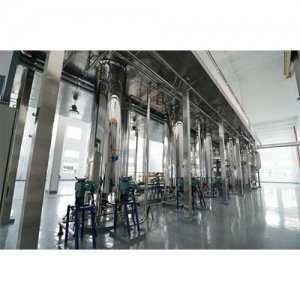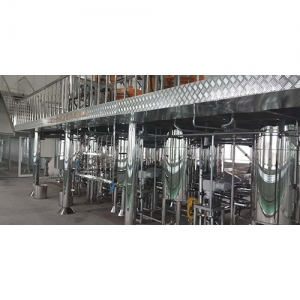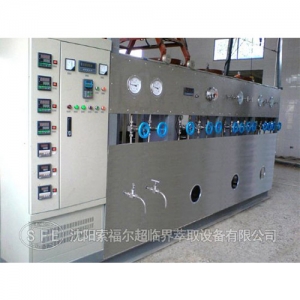The role of supercritical fluid extraction in tea processing
Date of release:2018-09-20 Author: Click:
Tea is rich in caffeine, which accounts for about 2 to 5 percent of dry matter. Caffeine is an alkaloid that has a wide range of effects on human metabolism. Decaffeination has been valued for its ability to meet the needs of specific populations, and because of the growing number of people in general who desire a healthy lifestyle. Decaffeinated black tea emerged as early as the 1950s. At first, organic solvent method was used, which could change the color, aroma, taste and shape of tea, especially the inevitable organic solvent residue. With the development of supercritical fluid extraction technology, people turn to supercritical CO2 extraction technology to produce decaffeinated black tea.
Tea has a unique aroma and flavor, and the composition of its aromatic and flavor substances is very complex. These components are mostly unstable substances, which are prone to thermal deterioration or volatilization. Therefore, the supercritical CO2 extraction method with low operating temperature is particularly superior.
Vitzthum(1975) was the first to study this aspect. Black tea was extracted with supercritical CO2 to isolate its volatile components, and 56 black tea aroma components were successfully identified by Porapak Q adsorption and enrichment. The extraction pressure was 10~ 30Mpa and the separation pressure was 5~7Mpa. In addition, since the early 80 s, the former federal republic of Germany with supercritical CO2 aromatic substances extracted from black tea as a food additive, extraction process conditions is temperature 40 ℃, 30 mpa pressure and time of 4 h.
Pigment is extracted from tea leaves
In recent years, more studies have been carried out on the extraction of pigment from tea leaves. Generally, organic solvent method is adopted. This method can obtain crude mixture of pigment, but the solvent is large in consumption, low in efficiency and high in cost. Green pigment was extracted from green tea by supercritical CO2 extraction (1996).
Extract tea polyphenols from tea leaves
Tea polyphenols is an important component of tea which has important physiological activities on human body. It has high medicinal value and strong antioxidant capacity. In recent years, the development and utilization of tea polyphenols has become a hot spot in tea deep processing. Now the production of tea polyphenols from the tea is using organic solvent method. Li jun et al. (1996) tried to study the tea polyphenols in tea leaves extracted from supercritical CO2, and the results showed that the solubility of tea polyphenols in supercritical CO2 was very low, and its weight fraction rate was only 10-6 orders of magnitude, and the solubility could only be increased to 10-6 orders of magnitude with the addition of certain entrainer. Supercritical CO2 under the condition of 80 ℃ and 21 mpa add 3.63% ethanol aqueous solution as entrainer, green tea extract 1 h, the extraction rate is only 0.215%.
In addition to the above mentioned aspects, supercritical fluid extraction technology is also applied in the essential oil extraction of tea fragrant flowers, extraction and refining of tea seed oil.
Application prospect of supercritical fluid extraction in tea processing
Due to its own characteristics, supercritical fluid extraction, which caters to the trend of pure natural development in the food industry, is stepping out of the laboratory and entering the stage of large-scale production and application at a relatively fast speed. It is believed that it has a good application prospect in the following aspects of tea processing.
Produce decaffeinated tea
Currently, the vast majority of decaffeinated tea is produced and sold in Europe and North America, and its consumption is increasing rapidly with good growth momentum. Not produce decaffeinated tea in our country, but our country has ability to manufacture large supercritical extraction device, and constantly improve, fully capable of industrialized production quality good decaf tea, for meet the demand of the elderly, children and special crowd of tea, enlarge the demand of the tea, expand tea consumption, solving the problem of tea backlog is very meaningful. The extraction of caffeine from tea leaves by supercritical fluid is also a good method to prepare natural caffeine.
Processing of tea
Flower tea is an important tea variety in China. The current processing method is to combine tea leaves and flowers, so that tea leaves can absorb flowers. The deficiency of this method is long processing time and low utilization rate of aromatic substances in flowers. Using supercritical CO2 to extract the aromatic substances from flowers and collect them is beneficial to storage and transportation. Then, supercritical CO2 is used to dissolve the aromatic substances in the flowers collected in advance. By decompression and expansion of CO2, the aromatic substances can be added to tea leaves. At this time, the aromatic substances of flowers can permeate into all parts of tea leaves rapidly, and their utilization rate will be greatly improved. Articles come from the Internet

Carbon dioxide extraction
The address of this article:http://www.sy-tc.com/en/news/379.html
Key word:Carbondioxideextraction,Aerogelequipment,Supercriticalfoamingequipment
Recently, browse:
Related products:
Related news:
- Supercritical CO₂ solvent content
- What factors affect extraction
- The application of carbon dioxide
- A brief explanation of supercritical extraction
- The development of supercritical fluid
- Product characteristics of supercritical fluid
- An overview of carbon dioxide
- Classification of reaction vessels
- What are the characteristics of supercritical carbon dioxide
- 9/5000 The way carbon dioxide is produced


















